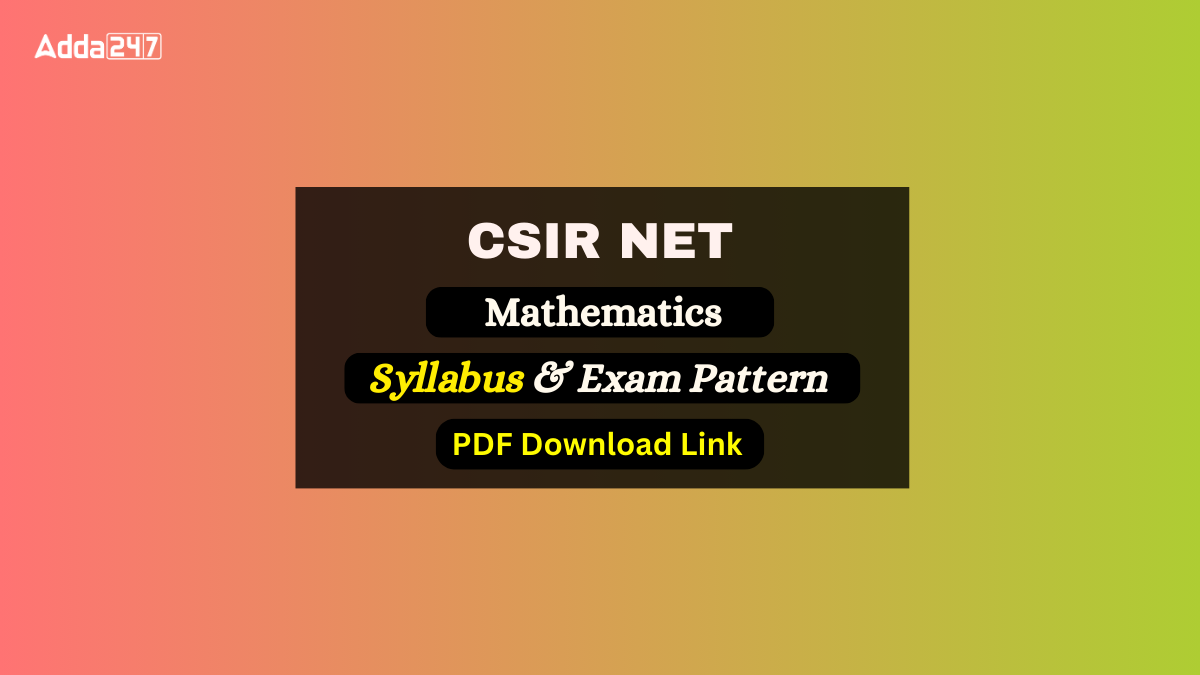Table of Contents
The CSIR NET Mathematics Syllabus for 2025 has been released by the Human Resource Development Group (HRDG) on its official website. The CSIR NET Mathematics exam comprises three sections: A, B, and C. Part A, known as General Aptitude, is uniform for all candidates. However, Part B and Part C are entirely subject-specific and are determined by the candidate’s choice of subject in the CSIR NET Exam.
CSIR NET Mathematics Syllabus
CSIR NET Syllabus for the Mathematics subject is an important tool that students must be aware of it. Here, we have provided the complete CSIR NET Mathematics Syllabus for all the subjects as prescribed by the CSIR. Candidates should go through the syllabus well in advance to prepare for the exam.
CSIR NET Mathematics Syllabus Topic Wise
Here we are mentioning each & every topic of the CSIR NET Exam for Mathematics Science Syllabus in the tabulated form for easy access. As mentioned above, a good understanding of the CSIR NET Mathematics Syllabus is essential in cracking any exam. The direct link to download the CSIR NET Mathematics Syllabus is given below.
CSIR NET Mathematics Syllabus for Part A
Part A is all about General Paper, which is common for all posts. Some of the important topics of CSIR NET Mathematical Science are partial differential equations, numerical analysis, calculus of variations, linear integral equations, classical mechanics, descriptive statistics, exploratory data analysis, etc.
| CSIR NET Mathematical Science Syllabus: Part A (General Aptitude) | |
| Graphical Analysis & Data Interpretation | Pie-Chart |
| Line & Bar Chart | |
| Graph | |
| Mode, Median, Mean | |
| Measures of Dispersion | |
| Table | |
| Reasoning | Puzzle |
| Series Formation | |
| Clock and Calendar | |
| Direction and Distance | |
| Coding and Decoding | |
| Ranking and Arrangement | |
| Numerical Ability | Geometry |
| Proportion and Variation | |
| Time and Work | |
| HCF and LCM | |
| Permutation and Combination | |
| Compound and Simple Interest | |
CSIR NET Mathematics Syllabus for Part B & Part C
Here we are sharing the important topic that is asked in the CSIR NET Mathematical Science exam. Candidates may revise all the important topics before appearing for the main exam. Parts B & C consist of the subject concerned part, which is based on the domain of the students.
|
CSIR NET Mathematical Science Syllabus: Part B & Part C |
|
| Unit 1 | |
| Analysis | Elementary set theory, finite, countable, and uncountable sets, the Real number system, the Archimedean property, the supremum, and the infimum. |
| Sequence and series, convergence, limsup, liminf. | |
| Bolzano-Weierstrass theorem, Heine-Borel theorem | |
| Continuity, uniform continuity, differentiability, mean value theorem. | |
| Sequences and series of functions, uniform convergence. | |
| Riemann sums and Riemann integral, Improper Integrals. | |
| Linear Algebra | Vector spaces, subspaces, linear dependence, basis, dimension, algebra of linear transformations |
| Algebra of matrices, rank, and determinant of matrices, linear equations. | |
| Eigenvalues and eigenvectors, Cayley-Hamilton theorem. | |
| Matrix representation of linear transformations. Change of basis, canonical forms, diagonal forms, triangular forms, Jordan forms. | |
| Inner product spaces, orthonormal basis. | |
| Quadratic forms, reduction, and classification of quadratic forms | |
| Unit 2 | |
| Complex Analysis | Algebra of complex numbers, the complex plane, polynomials, power series, transcendental functions such as exponential, trigonometric, and hyperbolic functions |
| Analytic functions, Cauchy-Riemann equations. | |
| Contour integral, Cauchy’s theorem, Cauchy’s integral formula, Liouville’s theorem, Maximum modulus principle, Schwarz lemma, and Open mapping theorem. |
|
| Taylor series, Laurent series, calculus of residues. | |
| Conformal mappings, Mobius transformations. | |
| Algebra | Permutations, combinations, pigeon-hole principle, inclusion-exclusion principle, and derangements. |
| Fundamental theorem of arithmetic, divisibility in Z, congruences, Chinese Remainder Theorem, Euler’s Ø- Ø-function, primitive roots. | |
| Groups, subgroups, normal subgroups, quotient groups, homomorphisms, cyclic groups, permutation groups, Cayley’s theorem, class equations, and Sylow theorems. | |
| Rings, ideals, prime and maximal ideals, quotient rings, unique factorization domain, principal ideal domain, Euclidean domain. | |
| Topology: basis, dense sets, subspace and product topology, separation axioms, connectedness, and compactness. | |
| Unit 3 | |
| Ordinary Differential Equations (ODEs): | Existence and uniqueness of solutions of initial value problems for first-order ordinary differential equations, singular solutions of first-order ODEs, and the system of first-order ODEs. |
| A general theory of homogeneous and non-homogeneous linear ODEs, variation of parameters, Sturm-Liouville boundary value problem, and Green’s function. | |
| Partial Differential Equations (PDEs) | Lagrange and Charpit methods for solving first-order PDEs, the Cauchy problem for first-order PDEs. |
| Classification of second-order PDEs, General solution of higher-order PDEs with constant coefficients, Method of separation of variables for Laplace, Heat, and Wave equations. |
|
| Numerical Analysis | Numerical solutions of algebraic equations, Method of iteration and Newton-Raphson method, Rate of convergence, Solution of systems of linear algebraic equations using Gauss elimination and Gauss-Seidel methods, Finite differences, Lagrange, Hermite, and spline interpolation, Numerical differentiation and integration, Numerical solutions of ODEs using Picard, Euler, modified Euler, and Runge-Kutta methods. |
| Calculus of Variations | Variation of a functional, Euler-Lagrange equation, Necessary and sufficient conditions for extrema. |
| Variational methods for boundary value problems in ordinary and partial differential equations. | |
| Linear Integral Equations | Linear integral equations of the first and second kind of Fredholm and Volterra type, Solutions with separable kernels. Characteristic numbers and eigenfunctions, resolvent kernel. |
| Classical Mechanics | Generalized coordinates, Lagrange’s equations, Hamilton’s canonical equations, Hamilton’s principle and the principle of least action, Two-dimensional motion of rigid bodies, Euler’s dynamical equations for the motion of a rigid body about an axis, theory of small oscillations. |
| Unit 4 | |
| Descriptive Statistics, Exploratory Data Analysis | Markov chains with finite and countable state space, classification of states, limiting behavior of n-step transition probabilities, stationary distribution, Poisson, and birth-and-death processes. |
| Standard discrete and continuous univariate distributions. sampling distributions, standard errors and asymptotic distributions, distribution of order statistics, and range. | |
| Methods of estimation, properties of estimators, confidence intervals. Tests of hypotheses: most powerful and uniformly most powerful tests, likelihood ratio tests. Analysis of discrete data and chi-square test of goodness of fit. Large sample tests. | |
| Simple nonparametric tests for one and two sample problems, rank correlation, and test for independence, Elementary Bayesian inference. | |
| Simple random sampling, stratified sampling, and systematic sampling. Probability is proportional to size sampling. Ratio and regression methods. | |
| Hazard function and failure rates, censoring and life testing, series and parallel systems. | |
CSIR NET Mathematics Exam Pattern
There is a negative marking of 25% in Parts A and B of CSIR NET Mathematical Science Subject, and there is no negative marking for Part C. Important topics include Combinations, Fundamental Theorem of Arithmetic, Divisibility in Z, Congruences, etc
| Mathematical Sciences | Part A | Part B | Part C | Total |
| Total Questions | 20 | 40 | 60 | 120 |
| Max No of Questions to attempt | 15 | 25 | 20 | 60 |
| Marks for each correct answer | 2 | 3 | 4.75 | 200 |
| Negative marking | 0.5 | 0.75 | 0 | – |
CSIR NET Mathematics Syllabus & Topic-Wise Weightage
Please refer to the table to know the total number of questions in each section & their marking scheme
| Subject | Total marks | Negative Marking | Marking Scheme |
| Mathematical Science | 200 | Part A: -0.5 | Part A: +2 |
| Part B: -0.75 | Part B: +3 | ||
| Part C: No Negative Marking | Part C: +4.75 |
CSIR NET Mathematics Syllabus PDF
Check out the CSIR NET Mathematics Syllabus 2025 PDF given in the following. The CSIR NET Syllabus PDF given below contains all the essential topics elaborately. CSIR NET Mathematics Syllabus PDF is easily shared or saved for future reference.
CSIR NET Mathematics Syllabus PDF




 HTET Syllabus 2026 (PRT, TGT, PGT), Chec...
HTET Syllabus 2026 (PRT, TGT, PGT), Chec...
 KVS PGT Syllabus 2025, Download PGT Syll...
KVS PGT Syllabus 2025, Download PGT Syll...
 KVS Syllabus 2025 For PRT, TGT, PGT and ...
KVS Syllabus 2025 For PRT, TGT, PGT and ...












